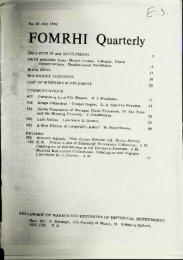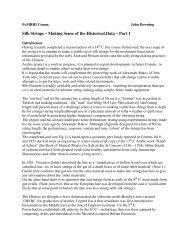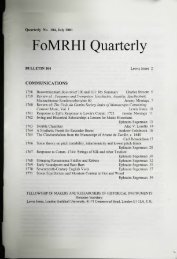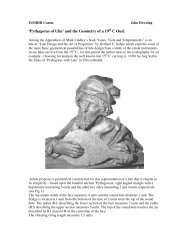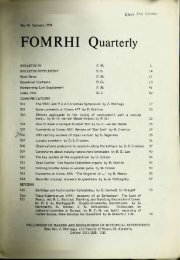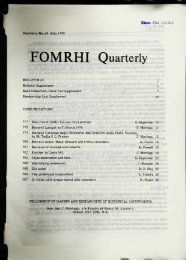•rf - FoMRHI
•rf - FoMRHI
•rf - FoMRHI
You also want an ePaper? Increase the reach of your titles
YUMPU automatically turns print PDFs into web optimized ePapers that Google loves.
p0PTrVm ^utri. «f*.<br />
MUSEUMS, COMMERCIALISM AND INSTRUMENT DRAWINGS<br />
E. Segerman and D. Abbott<br />
Several museums holding early instruments have been issuing drawings of<br />
these instruments at very commercial prices. The drawings are usually made very<br />
attractively and the price is comparable with other objects on the market which are<br />
similarly interesting as wall decoration. Another justification given by museum<br />
officials for the commercial price is that instrument makers are going to make profits<br />
from instruments constructed from the drawings, and the museum has a right to share<br />
in these profits. Though we could argue the last point, we will accept these justitications.<br />
Nevertheless we feel that there are many non-commercial instrument makers needing<br />
authentic design information on early instruments who are not being properly catered for.<br />
They often cannot afford to buy a commercially-macle instrument and are willing to trade<br />
considerale labour for cost to get an appropriate instrument to play on. The price of<br />
the drawing could doublé the financial outlay to make an instrument, and this can be a<br />
hardship.<br />
Another way that these museums neglect the amateur maker is that often not<br />
enough information is included in the drawing for an inexperienced maker to construct<br />
an instrument. The experienced maker can make better gucsses as to what this<br />
information will be, but the probability that he will produce a reasonably accurate copy<br />
is stili lowered.<br />
We do not argue with this policy if a museum wants to restrict its intended<br />
markets to interior decorators and professional makers, though we are sure that there<br />
is an element of convenient self-delusion involved in that amateur makers are a large<br />
fraction if not the majority of their customers.<br />
We have been shocked to discover that many museums expect to make the same<br />
profits from the sale of drawings of their instruments even if the measurements and<br />
the drawings are made by others and if the others intend to distribute these drawings<br />
on a non-prof it basis. Their legai position on this with respect to copywright law is<br />
highly questionarle (see Com. 28). So is their moral position as publicly supported<br />
caretakers of artefacts of our common history. Nevertheless we organologists need the<br />
cooperation of the museums in our researches so we need to play the game according<br />
to their rules no matter how illegal or immoral these may be.<br />
We appreciate that museums are underfinanced, in that what they feel they need<br />
to do costs more than their given budgets allow, so commercial operations can be very<br />
helpful. But whom to thus commercially exploit can be a problem when their prime<br />
purpose is to serve the public, present and future. Those who themselves commercially<br />
exploit the museums' holdings are reasonable victims, but what is a commercial<br />
enterprise is often a question of arbitrary interpretation. NRI Design Service, though<br />
non-profit, does charge money for the designs, and this factor alone seems to be enough<br />
for museums to class us as "commercial". If we paid the royalty the museums seem to<br />
expect it would more than doublé the cost of most of the designs to our members. Our<br />
members are hungry for information on instrument design, and since early instruments<br />
were much more diverse than modem ones, many designs need to be collected to get a<br />
perspective of the range involved in authentic design. Because of this need for<br />
quantity such a high price in designs is unacceptable.<br />
Our pian then is to try to workup designs in a rather scholarly and unartistic<br />
way and seek permission to distribute them from the museums holding the originai<br />
instruments. If they demand their pound of flesh for this permission, we will jre-do<br />
the design in a more scholarly and even less artistic way and try again. At worst the<br />
information could ali be verbal.and numerical with geometrica! analyses for ali shapes<br />
rather than outlines, and we can't imagine them having the audacity to charge us for that !





